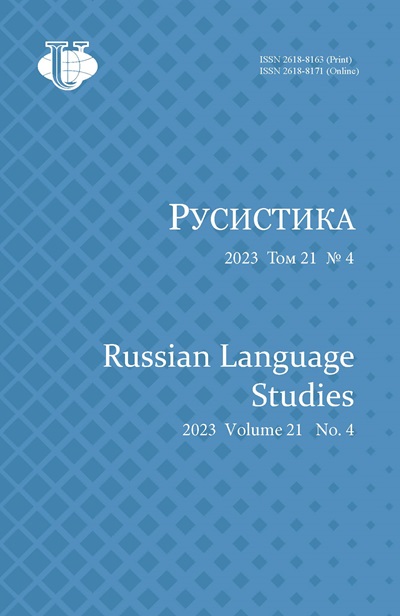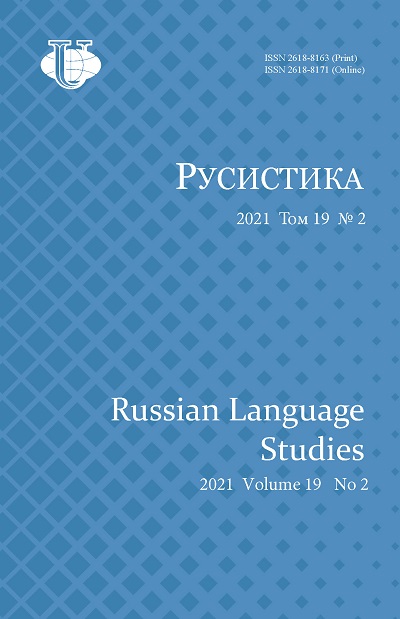Levels of tests of Russian as a foreign language in terms of school age characteristics
- Authors: Dubinina N.A.1, Ptiushkin D.V.1
-
Affiliations:
- Saint Petersburg State University
- Issue: Vol 19, No 2 (2021)
- Pages: 222-234
- Section: Modern Linguodidactics
- URL: https://journals.rudn.ru/russian-language-studies/article/view/26854
- DOI: https://doi.org/10.22363/2618-8163-2021-19-2-222-234
Cite item
Full Text
Abstract
The current paper discusses possibilities for school students to successfully pass TORFL-I/B1, TORFL-II/B2 and TORFL-III/C1. The relevance of this article is determined by the fact that despite Russian as a foreign (second) language has been taught within the framework of the TORFL system for more than two decades, there is a shortage of methodological material aimed at preparing school students for TORFL. In addition, the issue of choosing the level of testing in accordance with the level of Russian language proficiency and taking into account age specifics is not sufficiently covered in Russian academic literature. The aim of this paper is to define age reference marks for school students who plan to pass TORFL. The materials to review and analyse were the works of Russian and foreign researchers in the field of foreign (second) language proficiency, language development of children and adolescents, assessment of school students’ communicative competence, language assessment, and correlation of these data with the requirements for completing tasks of the TORFL-I/B1, TORFL-II/B2, TORFL-III/C1 “Writing” subtests selected as an example. The paper has resulted in providing recommendations on the choice of examination level for senior and junior school students, within the framework of TORFL-I/B1, TORFL-II/B2, TORFL-III/C1, which can also be used in the development of training courses in Russian as a foreign language for schools. The authors concluded that there is need to develop a new methodological area in testing of Russian as a foreign language system capable to provide guidelines and recommendations for preparing school students for examinations, and designing TORFL training courses and teaching materials according to the school students’ age.
Full Text
Table 1. Percentage of 12–17 year old TORFL candidates at the Language Testing Centre of Saint Petersburg State University from 2017 to 2020
Level | 2017 | 2018 | 2019 | 2020 |
ELT/A1 | 13,50% | 17,30% | 8,40% | 24,30% |
BLT/A2 | 13,70% | 13,10% | 16,90% | 14,20% |
TORFL-I/B1 | 6,30% | 7,90% | 10,50% | 10,10% |
TORFL-II/B2 | 3,40% | 3,40% | 4,90% | 9,90% |
TORFL-III/C1 | 5% | 4,20% | 7,70% | 5,70% |
TORFL-IV/C2 | 3,80% | 3,20% | 3,10% | 4,30% |
Table 2. TORFL-II/B2 and TORFL-III/C1, aged-based recommendations
Age | Levels recommended |
From 11–12 years | TORFL-I/B1 |
From 15–16 years | TORFL-II/B2 |
From 17–18 years (provided that necessary competencies are developed) | TORFL-III/C1 |
About the authors
Nadezhda A. Dubinina
Saint Petersburg State University
Author for correspondence.
Email: dnadine@yandex.ru
Russian language testing specialist of the Language Testing Centre
11/2 Leitenanta Shmidta Naberezhnaya, Saint Petersburg, 119034, Russian FederationDmitrii V. Ptiushkin
Saint Petersburg State University
Email: d.ptyushkin@spbu.ru
Director of the Language Testing Centre
11/2 Leitenanta Shmidta Naberezhnaya, Saint Petersburg, 119034, Russian FederationReferences
- Andryushina, N.P., Bitekhtina, G.A., & Vladimirova, T.E. (2014). Sample tests of Russian as a foreign language. The second certification level. General proficiency. Saint Petersburg, Moscow: Zlatoust Publ. (In Russ.)
- Averyanova, G.N., Belikova, L.G., Erofeeva, I.N., et al. (1999). Sample tests of Russian as a foreign language. The second certification level. General proficiency. Saint Petersburg: Zlatoust Publ. (In Russ.)
- Averyanova, G.N., Belikova, L.G., Erofeeva, I.N., et al. (1999). Sample tests of Russian as a foreign language. The third certification level. General proficiency. Saint Petersburg: Zlatoust Publ. (In Russ.)
- Common European framework of reference for foreign language: Learning, teaching, assessment: Monograph. Retrieved February 27, 2021, from http://learnteachweb.ru/articles/eurcomp.doc
- Council of Europe. (2018). Collated representative samples of descriptors of language competences developed for young learners. Volume 2. Ages 11–15. Retrieved February 27, 2021, from https://rm.coe.int/collated-representative-samples-descriptors-young-learners-volume-2-ag/16808b1689
- Doktor, R.M., Byukhner, E.A., Dubinina, N.A., & Ilicheva, I.Yu. (Eds.). (2017). Experience in preparation school students for TORFL. Russian Language Abroad. Special Issue: “Russian Studies in Germany” (pp. 30–33). (In Russ.)
- Dubinina, N.A. (2017). “Speaking” subtest of Test of Russian as a Foreign Language for Schools (C1 level). Testology: Collection of articles of 46 International Philological Conference (Saint Petersburg, 13–22 March 2017) (pp. 56–62). Saint Petersburg: Fond “Universitet” Publ. (In Russ.)
- Elnikova, S.I. (2010). National, age, social and cultural features as the factor of creation additional complexities at carrying out certified testing of Russian language as a foreign. Bulletin of Peoples’ Friendship University of Russia. Series: Problems of Education: Languages and Speciality, (4), 27–32. (In Russ.)
- Erikson, E. (1963). Childhood and society. New York: Norton.
- Hasselgreen, A., & Caudwell, G. (2016). Assessing the language of young learners. Sheffield: Equinox Publishing.
- Hoffmann, C. (1991). An introduction to bilingualism. New York: Longman.
- Ilicheva, I.Yu., Dubinina, N.A., & Azaryan, N.M. (2019). TORFL as an independent certification for schools (Bavarian experience). Russian Language on the Crossroad of the Epochs: Traditions and Innovations in Russian Studies: Proceedings of the IV International Conference (pp. 52–58). Yerevan: Russian-Armenian University Publ. (In Russ.)
- Korepanova, T.E., & Kalenkova, O.N. (2014). Testing of the Russian-speaking bilingual children. Russian Language Abroad, (3), 40–44. (In Russ.)
- Leontev, A.A. (Ed.). (1974). Main problems of theory of language activity. Moscow: Nauka Publ. (In Russ.)
- Little, D. (2006). The Common European Framework of Reference for Languages: content, purpose, origin, reception and impact. Language Teaching, 39(3), 167–190.
- McKay, P. (2008). Assessing young language learners. Cambridge: Cambridge University Press.
- Meyers-Scotton, C. (2011). Multiple voices: An introduction to bilingualism. Oxford: Blackwell Publishing.
- Nikolov, M. (Ed.). (2016). Assessing young learners of English: Global and local perspectives. Cham: Springer.
- Nippold, M. (2007). Later language development. Austin, Texas: PRO-ED.
- Papp, S., & Rixon, S. (2018). Examining young learners. Cambridge: Cambridge University Press.
- Passov, E.I. (1977). Major issues of training of foreign speech. Moscow: Russkii yazyk Publ. (In Russ.)
- Piazhet, Zh. (1994). The language and thought of the child. Moscow: Pedagogika-Press Publ. (In Russ.)
- Samatova, L., & Pavlova, E. (2019). Linguo-didactic diagnostics of children as a tool for assessing the quality of the linguo-didactic system of language teaching. For the Teacher of a Russian Language Supplementary School. Saint Petersburg: Zlatoust. (In Russ.)
- Sturikova, M.V. Model for the development of communicative competence of students in the conditions of continuity of education. Retrieved February 27, 2021, from http://human.snauka.ru/2015/11/12990 (In Russ.)
- Tseitlin, S.N. (2014). Child language acquisition. Saint Petersburg: Zlatoust Publ. (In Russ.)
- Vygotskii, L.S. (1987). The collected works. Moscow: Academy of Pedagogy in USSR Publ. (In Russ.)
- Yurkov, Y.Y., Protassova, E., Popova, T., & Nikunlassi, A. (Eds.). (2012). Development and assessment of bilingual communicative competence in the process of bilingual education. Saint Petersburg: MIRS Publ. (In Russ.)















